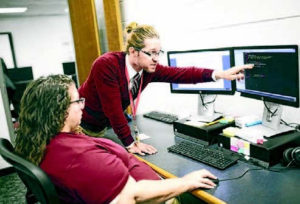
Coding instructor Quincy Williams helps Stacy Orue during a class at the Indiana Women’s Prison in Indianapolis.
INDIANAPOLIS — Jennifer Fleming was convicted of dealing drugs in 2012, but when she gets out of prison next year, she is hoping for a job in computer coding.
“Technology is definitely going to be a steppingstone in keeping myself stable,” said Ms. Fleming, who is one of eight women in a pilot program at the Indiana Women’s Prison that officials plan to roll out to other prisons in the state. Ms. Fleming, 40 years old, passed a test and two rounds of interviews to be accepted into the program.
The program called The Last Mile aims to help inmates find work and stay out of prison once they are released. Researchers at Rand Corp. have found that inmates who participated in educational programs were 43% less likely to return to prison than inmates who didn’t.
Ex-inmates are typically among the last groups on the sidelines of the jobs market. The U.S. economy has been in a sustained period of low unemployment with many states across the Midwest and Northeast, in particular, experiencing labor shortages and employers needing to reach further for workers.
Officials in Maine, which had a 3% unemployment rate in July, are inviting employers to the state prison in Warren for a seminar on hiring prisoners in September. Organizers expected between 25 and 50 employers. So far, 114 have signed up, from retailers to construction companies. The state is proposing that employers send their own managers into prisons to train inmates.
“Everywhere you go up here, there are help wanted signs,” said Ed Upham, director of the state’s Bureau of Employment Services. “This is an overlooked population whose time has come.”
In Wisconsin, where the unemployment rate was 2.9% in July, about 20 current inmates build semitrailers for Stoughton Trailers LLC through a state work-release program to hire prisoners. They work as entry-level assemblers up to advanced welders earning as much as $20 an hour. Initially, the program was a tough sell for managers, but today the inmates who arrive every day provide a buffer against absenteeism, said Meghen Yeadon, a human-resources recruiter for the trailer maker who oversees the program.
“They want to be here and work as many hours as they can,” she said. Since last year, the company, which employs 1,250 manufacturing workers, has hired about five inmates into full-time positions upon their release.
The Last Mile, founded in 2014, operates in Indiana as well as in six correctional facilities in California. All 50 people who have completed the program in California and been released are employed, and none have returned to prison, the organization said.
Indiana has a 37% recidivism rate within the first three years of release, and 75% of former inmates are unemployed one year after being released. The state houses 27,000 offenders in 23 prisons, and 90% of inmates will be released back into society.
“Many of the tech companies see the value of what we’re bringing to the community,” said Kenyatta Leal, a cofounder of The Last Mile and a former inmate himself. He said the nonprofit is in negotiations to expand the coding program into prisons in Kansas, Oklahoma and Arizona. In Indiana, the first year of the program cost $130,000 and was paid for by a family in the state.
At the Indiana Women’s Prison, classes are held from 7:30 a.m. to 3 p.m. five days a week. Because inmates aren’t allowed internet access, the women study versions of sites downloaded by their instructor. They sit in front of computer screens and work through assignments at their own pace, learning how to create websites with navigation bars and dropdown boxes. Other assignments include writing the code for features like making dots appear on a screen and change color.
Organizers say participants will do about 800 hours of programming over the yearlong course. “This is a tough program,” said Laurie Johnson, the prison’s warden.
Ms. Fleming said that before her arrest she had relapsed into addiction while taking care of her father as he was dying of lung cancer. She lost custody of her three children. She hopes to get a job to help pay off her $47,000 in student debt, which she said came from studying at Purdue University where she was a semester shy of completing a bachelor’s degree.
She showed off her 99.01% average for the course, and then used a tool to find errors in 9,566 lines of code, including one where an extra space had been inserted. “This is so precise,” she said.
This article originally appeared in The Wall Street Journal
